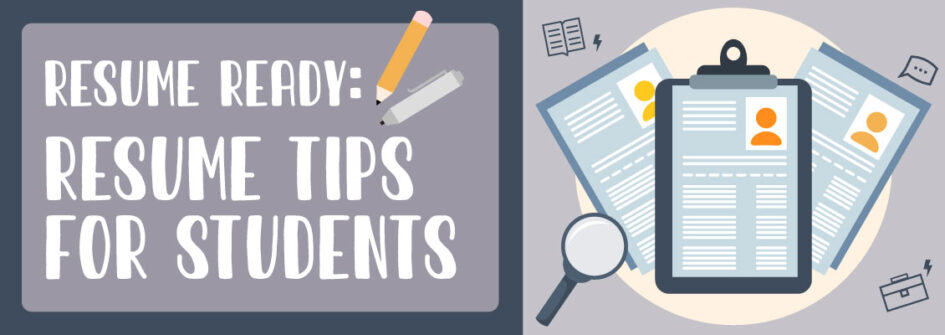As a college student preparing to enter the workforce, your resume serves as your first impression to potential employers. Since you may have limited professional experience, it’s essential to strategically highlight your strengths, skills, and potential. A well-structured resume will show employers that you’re ready to contribute to their team, even if your career journey is just beginning.
Read on to learn more about how to craft a great resume, with an example resume at the end.
Objective
While the “objective” section is optional, it can be a great way to briefly explain what kind of job you’re looking for and how your skills align with the company’s needs. Keep it concise and targeted to the role you’re applying for. Instead of using generic statements, like “seeking a challenging position,” try to tailor your objective to the specific job or industry.
A well-crafted objective helps employers quickly understand what you’re looking for and how you can contribute to their organization.
Education
Under the education section, include the following:
- University name
- Degree
- Major
- Expected graduation date
- Cumulative GPA – see below
- Honors (if applicable) – Dean’s List, academic scholarships, honor societies, etc.
While employers are not particularly concerned about GPA, you may consider including it if your GPA is at least a 3.6. This can be particularly impactful if you’re applying for jobs that prioritize academic performance. Regardless of your GPA, employers focus more on the specific skills and experience you can bring to the job.
Work Experience
Even if you don’t have much formal job experience, it’s important to list any positions that demonstrate your skills, work ethic, and initiative. This could include part-time jobs, internships, research assistantships, or volunteer work. Make sure to list your experiences by date, starting with the most recent position.
For each position, include the company name, location, position title, role duration, and bullet points highlighting your responsibilities and tasks under the position. In addition to your responsibilities and tasks, also try to share the impact you made in each position. When possible, try to include metrics to quantify your achievements.
Each bullet point should start with an action verb that would stand out to the employer and compel them to read on, and include the impact you made in that position. Example words could be: managed, produced, developed, created, assisted with, utilized, collaborated with, and led. If you are describing a current position, use present tense verbiage. You may also include any soft skills (communication, time management, leadership, etc.) within these bullet points. Oftentimes, employers run resumes through a software that detects certain tag words, so you want to strategize which ones you use when crafting your resume. It is very important to tailor your resume to each job you apply to, making sure to include keywords from the job description on your resume.
Leadership and Activities
Many college students gain valuable experience through leadership roles or participation in campus organizations. This section can demonstrate your ability to manage projects, work in teams, and contribute to your community. Even if you are simply an active member of one organization, add it to your resume as that shows that you are involved in something rather than only going to class.
Definitely list any leadership positions (e.g., president of a club, team captain) or other involvements that show your initiative. Don’t forget to highlight any special projects or initiatives that made an impact.
Skills and Certifications
This section is critical for showing your technical and soft skills. Depending on the job you’re applying for, the skills section can vary widely. It can include both hard skills (technical, job-specific skills) and any relevant certifications (Google My Business, Hootsuite Marketing, Python certification).
Be specific about the tools, technologies, and programs you’re proficient in, such as Microsoft Office, Adobe Creative Suite, or any coding languages. Additionally, include any certifications that are relevant to the job you’re applying for. By listing specific tools and certifications, that sets you apart from other candidates who are not able to offer that to the company. Simply, the more you know, the more valuable you are to the company.
Bonus Tips for College Students
- Keep It Concise: Aim for a one-page resume and be selective about the information you include.
- Tailor Each Resume: Customize your resume for each position you apply to. Highlight experiences and skills that are most relevant to the specific role.
- Proofread: Make sure your resume is free of typos and grammatical errors. Consider asking a peer, mentor, or career advisor, to review it and offer suggestions for improvement,
Example Student Resume

Bottom Line
Take your time refining each section, and don’t forget to update your resume regularly as you gain new experiences and skills. The goal is to make your resume an honest, compelling representation of your strengths and future potential. By crafting a targeted, well-organized document that highlights your education, work experience, leadership, and technical skills, you’ll put yourself in a strong position to land internships, part-time jobs, or full-time roles after graduation.This blog is in collaboration with UW-W Career Services. For additional guidance, contact UW-W Career Services at career@uww.edu or set up a resume review appointment with a Career Advisor using the Navigate app.

February 3, 2025 at 4:10 am
This blog highlights the importance of preparing a resume early, especially for students. A well-crafted resume can help you stand out, showcasing your skills, experiences, and achievements clearly and professionally.